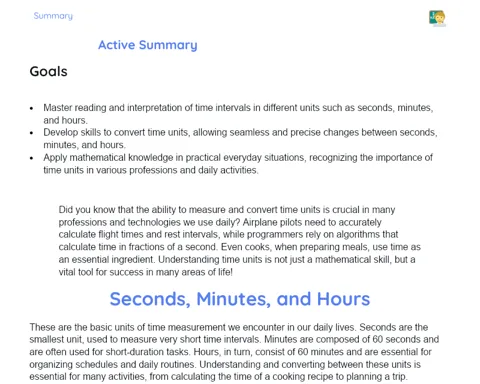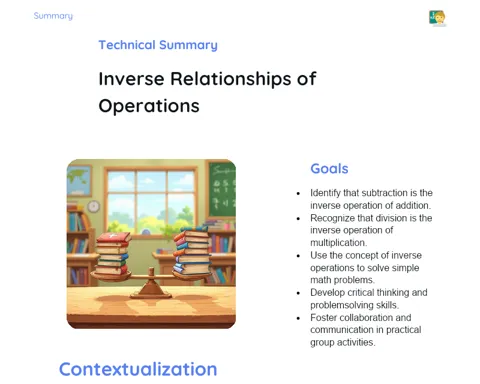INTRODUCTION
Relevance of the Theme
- Knowing the sequence of events of the day is like knowing a cake recipe. We need the right ingredients (actions) and mix them in the correct order for our day to go well!
- Studying the daily sequence helps to understand time. Time is like a dance that follows music. Each step (event) comes one after the other.
- Mathematics is not just numbers! It teaches us about the order of things. How to line up the moments of the day, just like numbers!
Contextualization
- Just as we learn to count, learning the sequence of the day is important to organize actions and tasks.
- This lesson is one of the first steps to understand schedules and routines, which are essential parts of everyday math.
- Connecting daily events with times sets the stage for more complex skills, such as reading the time and understanding calendars.
Remembering that this sequence is not only useful at school, but also at home, in games, and even when planning fun. Everything has its time, and knowing this is as powerful as having a magical super clock!---
THEORETICAL DEVELOPMENT
Components
-
Event of the Day: A specific moment or activity that occurs at a certain time.
- Importance: Helps to understand that the day is divided into parts with different actions.
- Characteristics: It can be something we do every day (routine) or special events.
- Contribution: By knowing the events, we can plan what to do first, second, and so on.
-
Sequence of Events: The order in which events occur from the beginning to the end of the day.
- Importance: Teaches to prioritize tasks and manage time.
- Characteristics: It has a beginning, middle, and end, like a story.
- Contribution: With the sequence, we know what to expect and prepare better for the day.
-
Time: The exact moment when an event occurs during the day.
- Importance: Helps to synchronize activities with other people and established schedules (school, meals).
- Characteristics: Can be said in hours and minutes, using the clock.
- Contribution: Understanding time is the first step to learn how to read the time.
Key Terms
-
Routine: Set of regular activities that repeat in the same sequence every day.
- Explanation: Routines give structure to the day and create healthy habits.
-
Time: Measure in which events happen, past, present, and future.
- Explanation: Time is an abstract concept, but we experience it concretely through daily events and clocks.
-
Schedule: A plan that indicates the sequence of events and the times associated with each one.
- Explanation: It's like a map of the day, showing what will happen at different times.
Examples and Cases
-
Example of Morning Routine:
- Wake up at 7:00 AM.
- Brush teeth and take a shower.
- Have breakfast at 7:30.
- Prepare the backpack and go to school at 8:00.
- Explanation: Each action follows the other in an order that repeats every day. This helps the child to be ready for school on time.
-
Example of Sequence of Events After School:
- Return home at 12:00.
- Have lunch at 12:30.
- Do homework at 13:00.
- Play at 14:00.
- Explanation: This sequence shows how to divide the time after school between responsibility (homework) and leisure (playing).
-
Example of Schedule for a Birthday Party:
- Start of the party at 3:00 PM.
- Games and activities at 3:30.
- Snack at 4:30.
- Open presents at 5:00.
- End of the party at 6:00.
- Explanation: The schedule shows the sequence and times of the events during the party, ensuring there is time for all planned activities.
At the end of the class, the students should visualize their own daily routine and identify sequences of events and corresponding times, understanding how mathematics helps to organize the day.
DETAILED SUMMARY
Key Points
- Practical Learning: The class practiced how to identify the sequence of events in a typical day, starting from waking up, going through routine activities until bedtime.
- Importance of Routine: It was emphasized that following a planned routine helps not to forget important tasks and keeps the day organized.
- Use of Times: The class showed how to use specific times for each event, reinforcing the concept of duration and the passage of time.
- Learning Tool: Playful examples, such as programming a birthday party, were used to visualize the concept of sequence of events.
- Connection with Mathematics: It was evidenced that understanding sequences and times is a mathematical skill applied in everyday life.
Conclusions
- The sequence of events of the day helps the child to understand how time is organized and the importance of following an order.
- Associating events with specific times develops the notion of time and responsibility.
- The activity of creating a personal schedule for the day encourages autonomy and the practical application of mathematical learning.
Exercises
-
My Illustrated Day:
- Draw the sequence of events of a typical day, putting the times next to each activity.
-
What Comes Next?
- Receive a list of mixed events and put them in the correct order, as they happen from the beginning to the end of the day.
-
Weekend Schedule:
- Create a schedule for Saturday or Sunday, including times for fun activities, such as watching a movie or going to the park.
By completing these exercises, students will strengthen their ability to organize their daily activities and understand the relationship between sequence of events and times.



